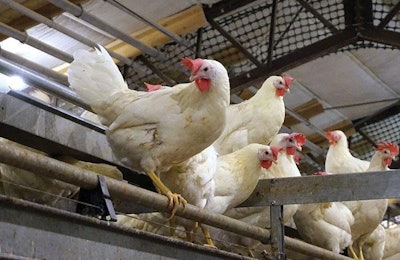
While attending the U.S. Poultry & Egg Association (USPOULTRY) Live Production, Welfare & Biosecurity Seminar in Nashville, Tennessee, on September 17, industry researchers discussed potential issues to cage-free layer housing that U.S. egg producers may not have faced yet.
Among the issues were toe pecking, red mites, and beak trimming -- all of which are already issues in Europe. In fact, according to an epidemiological review found in the article, “The Poultry Red Mite, A small pest that packs a big punch,” by Monique Mul from Wageningen University & Research, red mites cost the European poultry industry an estimated US$447 million a year.
While the U.S. hasn't seen toe pecking or the phasing out of beak trimming, industry researchers said they believe it is coming.
So, why does that matter?
During my layover in Chicago on the way home from the conference, I was seated next to a man from California. After multiple flight delays, we started talking about our careers. I shared with him that I do a lot of writing about the egg industry.
He nearly jumped out of his chair at the chance to share with me his disgust with California's new egg laws and cage-free commitment. He said, "would you believe most the people who voted for cage-free facilities don't even know what it means to be cage-free?"
I chuckled, yes, I would have guessed that. He started asking me questions about the health and welfare of the birds in a cage-free setting. I told him that while some companies have done a great job of combating the issues with cage-free egg production, there still may be more issues to come, like the health concerns mentioned earlier. Not to mention other economic concerns like egg eating by layers, and cutting down on available production for retail.
Then he asked the real kicker, how long will HSUS be okay with cage-free before they have other demands, and what will that cost the industry, especially, if there are more potential issues ahead?
I had no straight answer for him. Does anyone? I did tell him I'm afraid the day will come when HSUS will have different demands and that animal activists are not going to slow down in their fight against commercial farming. I'm just thankful HSUS has agreed to follow the United Egg Producers standards at this point.
I assured him that producers do their best to prepare for the issues that may be ahead, like the ones above, but that without a clear road map we are all just trying to make the best of what we have to give consumers an optimal product.
He asked me, how families that count on eggs as a cheap form of protein would come up with the extra cash for the premium cost? I had no answer. I'm not sure any of us do, hence the fear in following California's lead. Not to mention the food safety standards and regulations coming down the pipe could add to the premium cost.
He seemed puzzled by how complicated the cage-free egg situation is and, honestly, I was just elated that someone from outside the agriculture circle was just willing to ask questions and listen.















